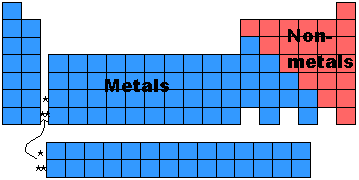Molecular Substances
- When two or more atoms are bonded together with covalent bonds
a molecule is formed.
- Molecules are primarily formed from the nonmetal elements. See the illustration
below:
- Using a piece of software called "eChem" you can experiment with
how various nonmetal atoms will bond covalently to form molecules. You can
download "eChem" here: http://www.investigationstation.org/sciencelaboratory/echem/download.html
- Molecules tend to fall into 4 broad categories:
- Small molecules
- These molecules consist of a small
number of atoms strongly bonded together.
- Most room temperature liquids, and gasses consist of small molecules.
- Some examples include: water, ammonia, butane, gasoline, air (nitrogen
and oxygen)
- Large molecules
- These molecules consists of a
large number of atoms strongly bonded together.
- Many biologically important substances consist of large molecules.
- Some examples include: vitamins, hormones, various cellular signaling
molecules
- Polymers
- These molecules consist of repeating
small molecules bonded together to form larger molecules.
- Polymers are also large molecules, but they can be much larger than
some of the large molecules listed above.
- Some examples include: plastic, wood, DNA, proteins, enzymes (a
type of protein with a special function).
- Network molecules
- All previous examples involved
molecules that were somewhat linear or sequential, with one atom bonded
to the next and so on. Sometimes a network of bonds can form between
many neighboring atoms.
- Network molecules tend to have great relative strength because of
the many covalent bonds connecting neighboring atoms. Some newly created
molecules of this type are promising to revolutionize everything from
drug delivery, to computer processing power.
- Some examples include: diamond, buckyballs, and carbon nanotubes.
To see examples of the above molecule types, go to the
Melange of Molecules web pages. Just close the window of molecules
when you are done.
